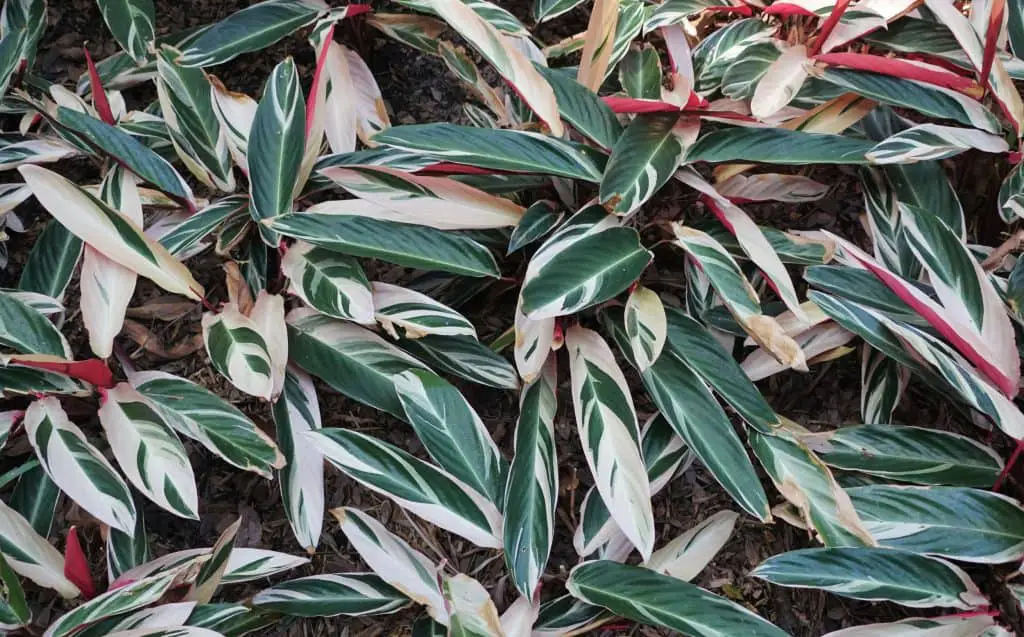| Common Name(s) | Calathea Triostar, tricolor stromanthe, tricolor ginger |
| Scientific Name | Stromanthe Sanguinea |
| Sun Exposure | Bright indirect sunlight |
| Soil pH | 6.5 |
| Watering Requirement | Keep moist but not saturated |
| Hardiness Zone | USDA zones 9-11 |
| Plant Height | 2-3 Feet |
| Plant Width | Leave and stems can each be 6-12 inches |
Calathea Triostar is easily recognized by its many-colored leaves. The tops are covered in a somewhat random pattern of white and muted yellow with some light green thrown into the mix as well. Each leaf and therefore each plant is unique in its variegation. The bottoms of the leaves boast a beautiful blush color. The leaves are long and end in a subtle point giving Calathea Tristar a gentle, tropical aesthetic.
As a member of the Marantaceae or prayer plant family, Calathea Triostar leaves fold up at night to resemble praying hands. This is to conserve energy since they are a shade-dwelling plants and don’t soak up as much sun as some other tropical plants.
The tropical rainforest of Brazil is where the wild Calathea Triostar calls home. They grow close to the ground and only receive indirect sunlight through the tree canopy of the jungle.
What are the benefits of keeping a Calathea Triostar?
Calathea Triostar is an air purifier. In addition to taking in carbon dioxide and releasing oxygen, it also eliminates harmful particles from the air in its environment. It is an excellent plant to have in the bedroom for filtering the air and helping you wake refreshed.

Calathea Triostar Care
This is definitely not a plant for beginners. Calathea Triostar has some very specific demands when it comes to the best care. It is quite particular about temperature, watering, and humidity.
How to care for Calathea Triostar as an indoor plant
A north or east-facing window in your home is the best place for your Calathea Triostar to rest. They are not able to handle intense light, but if the light is too low they will start to lose their variegation. They also need a very humid and warm spot to live their best life indoors. A bathroom windowsill might be the most ideal spot for them to get just the right light and bask in all of the shower steam.
How to care for Calathea Triostar outdoors
Whether in a pot or as part of the landscape, make sure your Calathea Triostar is in a shady location. They are sensitive to full direct light and burn easily. Also, check on the outdoor humidity in your area. Calathea Triostar requires high humidity and will not fair well in a dry climate.
Calathea Triostar Lighting Requirement
Calathea Triostar requires bright indirect sunlight. They can be placed near a north or east-facing window (no more than 4 feet away). If only south or west-facing windows are available, try filtering the light with window sheers. If the light is too direct the Calathea Triostar leaves will burn, if it’s too low the stunning colors Calathea Triostar is known for will start to fade as it needs to use the limited light it’s getting as efficiently as possible.
Soil Type and pH requirement
A Calathea Triostar soil hack is to use an African Violet mix. It’s a light soil that retains water well and doesn’t get muddy.
If you prefer to mix your own soil try a mix of 2 parts peat moss, 2 parts perlite, and 1 part potting soil or compost.
A soil pH of 6.5 is optimal for Calathea Triostar.
Watering Requirements
Moist but not soaking wet soil is what Calathea Triostar needs for survival. They are not happy to have their soil dry out and the moisture level should be monitored regularly.
Calathea Triostar is also sensitive to minerals that are often found in tap water and should not be given said water right away. Use filtered water, rainwater, or water from the tap that has been sitting out for at least 12 hours to allow chlorine and fluoride to dissipate.

Humidity Requirement
Because their natural home environment is the rainforest of Brazil Calathea Triostar likes to live in very humid places. Some other Calathea plants require 90% humidity. Unfortunately, that level of humidity isn’t ideal for home and office buildings. To keep your Calathea Triostar highly humid you can try placing them in a bathroom window, spraying or misting your plant every 1-2 days, and using a small humidifier near your Calathea Triostar (and other humidity loving plants).
Temperature Requirement
Calathea Triostar definitely likes cozy temperatures. They want to stay in the range of 65F-85F. If growing them outside make sure nighttime temperatures are not dipping below 60F.
If indoors keep your Calathea Triostar away from any air conditioning vents. (Heat vents are also a problem because they are very drying)
Hardiness Zone
If grown outside Calathea Triostar thrive best in a hardiness zone of 9 USDA to 11 USDA.
Fertilization Requirement
Growing season (early spring to summer) is the time to fertilize Calathea Triostar. Fertilize your plant about once a month during this time with a commercial liquid plant food. Be sure to dilute it to a quarter of the recommended amount as too much fertilizer can quickly kill Calathea Triostar. A good rule of thumb is there is no such thing as too little fertilizer.
Calathea Triostar Propagation
Plant division is the most successful way to propagate Calathea Triostar. They do not root in water, so it will not work if you try propagating with a simple cutting, it will not work. The best time to propagate Calathea Triostar is when you are repotting your plant. Early spring is the recommended repotting season. Once the parent plant is gently removed from its container and the roots are free from excess soil start carefully separating the root ball from the parent plant. Make sure there are some leaf stems with the roots you are taking.
A small knife or sheers sterilized with rubbing alcohol can also help the process.
Repot the parent plant in a new container with clean fresh soil.
Plant the new plant in its own container and make sure to place it in a warm spot with indirect light. Keep the soil moist and watch for new leaf growth. That will be your sign that the baby Calathea Triostar has rooted.
Calathea Triostar Size & Growth Rate
Once mature Calathea Triostar grows to be 2-3 feet tall and 1-2 feet wide. A healthy plant has a moderate growth rate.
Common Problems
Although they have a persnickety personality, Calathea Triostar is relatively hardy when it comes to pests and diseases.
Two common problems to look for are aphids and fungal infections. The high humidity requirement can make them susceptible to mold and root rot as well.
Leaves Turning Yellow
Leaves that are turning yellow mean your Calathea Triostar needs more light or it’s being overwatered. Try moving your plant to a brighter indirect light location or changing your watering schedule. Only water when the top layer of soil is dry.
Leaves with brown edges
If the edges of your Calathea Triostar leaves are turning brown it’s a good indication that the humidity is too low. Try using a humidifier or misting the leaves every day.
Drooping leaves
Low humidity can cause leaves to droop and can also attract spider mites. Neem oil can rid your Calathea Triostar of spider mites. Try moving it to a bathroom location or using a humidifier nearby to perk up the leaves and prevent reinvasion.
Plant dying
If your Calathea Triostar appears to be dying, try repotting it in clean soil, check for pests and root rot, and make sure it has been placed in an ideal living environment for its optimal health.
How to Repot Calathea Triostar
Repotting should happen in early spring when necessary. It is a very stressful procedure for Calathea Triostar and it will probably go into shock for about a week.
When repotting, tenderly remove the Calathea Triostar from its original container. Jiggle the dirt from its roots and check for any damaged or mushy roots and remove them.
Place some new clean soil in the fresh pot filling it about halfway. Place your Calathea Triostar on the soil and fill more soil around it. Lightly tap down the soil and water thoroughly.
Place in bright indirect light and keep your Calathea Triostar warm.
Do Calathea Triostar flower?
It is rare for Calathea Triostar to bloom when kept indoors. In their native habitat, they blossom with orangy-red buds that turn into bubble gum pink flowers when fully opened.
Does Calathea Triostar move at night?
Calathea Tristar leaves fold upward at night to conserve energy. This is why they are called a prayer plant as it looks like they are folding hands for nighttime prayer.
Is Calathea Triostar safe for pets?
Calathea Triostar is safe and non-toxic for cats and dogs.
Where can I find Calathea Triostar for sale?
Calathea Triostar can be purchased online and in some specialty plant stores. Their price ranges from 13 USD -20 USD.
